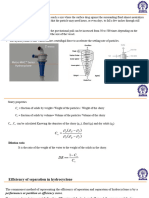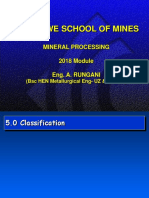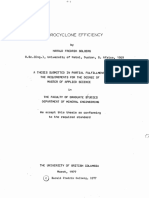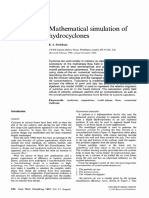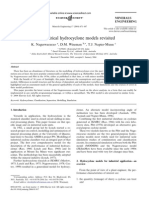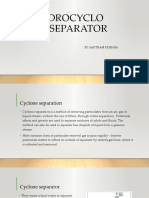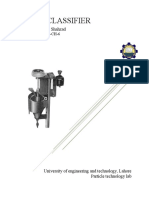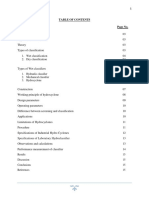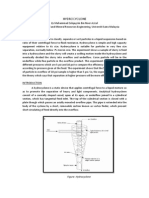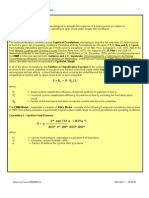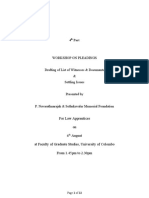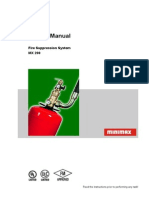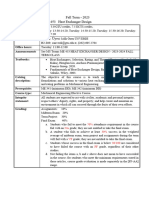CLASSIFICATION
Rake classifier Settling
cone
Hydrocyclone
Screw classifier
CLASSIFICATION CIRCUIT
Consider a closed circuit milling operation
Fine Product (d80:50 to 500µm)
Coarse Classifier
Circulating
Load
(d80:0,2-15mm) Mill
New feed Mill Discharge
Particle sizes in the feed:
(Semi) Autogenous Grinding: <200mm
Rod mills: <20mm
Ball mills: <10mm
Objective of classification:
Remove particles which are “fine enough”
Prevent overgrinding
Save power – or increase kwh / tonne
Increase throughput
1
� Key issue: Settling velocities of particles in fluids
Comparison of Stokes and Newtonian behaviors
Stokes Newton
NRe < 0,2; laminar 1000 to 200000; turbulent
( ρ s − ρ f ) gd 2 3dg ( ρ s − ρ f )
u 18µ
[ ]0.5
ρf
Size effect d2 d0.5
Density effect ρs − ρ f ( ρ s − ρ f ) 0, 5
Viscosity effect inverse None
Gravity g g0,5
Exercise on Settling Velocity
(a) Consider two large particles of diameter 10 mm
with different densities ρs1 = 3500 kg/m3 and ρs2 =
5100 kg/m3 settling in a dense medium with ρf =
3000 kg/m3. What is the ratio of their settling
velocities?
(b) If two differently sized particles of these
densities settle at the same rate, what is the ratio of
their sizes?
( c ) why would this information be significant?
2
� Mechanical Design of a Cyclone
•Slurry pumped in at pressure P
•most water goes to overflow
and drags fine particles with it
•coarse particles migrate to wall
and go to the underflow
•some water also goes to
underflow containing fine
particles = Bypass fraction
Adjusting performance of an existing
cyclone: adjust
•Inlet diameter
•Apex diameter
•Vortex finder diameter and length
The Hydrocyclone
Feed
Underflow Overflow
(Coarse Product) (Fine Product)
Diagram kindly supplied by MULTOTEC
3
�The hydrocyclone - principle of operation
Settling velocities of particles in
Path of d50
particle fluids = f(ρ, d)
d50 = diameter of particle which has
u equal chance of going to overflow or
underflow
= cut size of cyclone
d < d50
u and v are functions of :
v l > l50
•cyclone geometry
•volumetric feedrate
Hence we can obtain d50 as a function
of these variables
Note: for settling g cause particle to fall, in this case v2/r causes
particles to accelerate outwards.
The hydrocyclone:
behavior of underflow
Normal “roping”
underflow pattern underflow pattern
Unacceptable
operation
4
� Quantification of Cyclone Performance
Calculate the Partition Curve:
po(d) MFipFi= Mopoi+Mupui
Mo Rui(d) = recovery of solids to U/F in size-class i
Q m3/s
φvsol vol frac Mupui(d)
pF (d) = MFpFi(d)
MF (kg/s) pu
Mu
Conceptual Model for Bypass:
Bypass contains feed particles at feed concentration
True
class RF = fraction bypassed to the underflow
process
Fraction short-circuits
directly to Underflow
CLASSIFICATION FUNCTION
Normal Ideal
Classifier Classifier Possible with process
Chance Chance
Particle improvements
of being of being
Size oversize 100
oversize
Chances of being oversize
40 95 100 80
Ideal
Classifier
60
85 100 Our
20
40 classifier
as per table
10 50 50 20
0
1 10 100
5 20 0
ParticleSize
10 0 di=Cfi λ
2.5 di
− .693
Ci = 1 − e d 50
5
� Partition Curve for Cyclone Behaviour
Bypass phenomenon
These particles move
to the underflow-
are classified
Feed λ is related to the slope
A/B; it is called the
O/F sharpness of
classification
U/F
These particles are already
in water going to the U/F
∴are not classified ℓ
d50 d50c
For practical purposes Recovery to U/F of classified material
use (d75 –d25)/2d50 for Experimental: RUci = (Rui – Rf)/(1 – Rf)
slope Model: RUci,mod = 1 – exp(-.693(di/d50c)λ)
